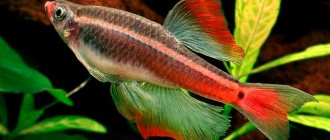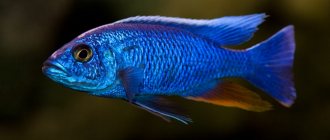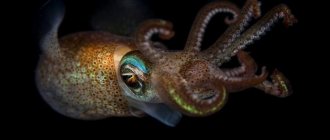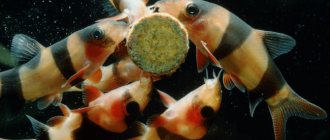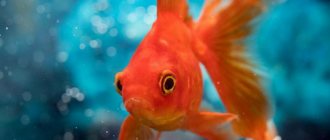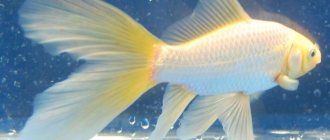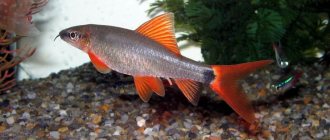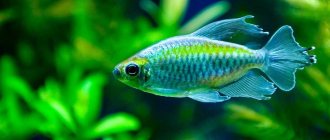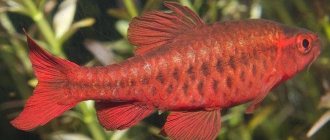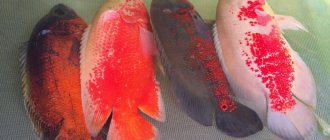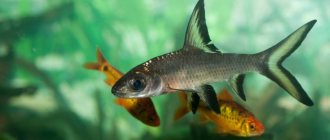Veiltail is perhaps the most popular member of the goldfish family. They can be found everywhere in our pet stores and bird markets. The veil tail has gained such popularity due to its unpretentiousness and, of course, beauty. Well, let's take a closer look at these representatives of the golden family.
The color of the body and fins is red-golden, the back is darker than the belly. Other colors: pale pink, red, white, black, black-blue, yellow, dark bronze, fiery red. The goldfish has an elongated body, slightly compressed from the sides. It is possible to distinguish males from females only during the spawning period, when the female’s abdomen becomes rounded, and the males develop a white “rash” on the pectoral fins and gills.
A little history of the veiltail and goldfish
Veiltail (fantail) is an artificially bred ornamental breed of “goldfish” (lat. Carassius gibelio forma auratus (Bloch, 1782)), which is known for its elongated fins and a longer, more fluffy veil tail - compared to other representatives of this “species”.
It is interesting to know that goldfish were bred in China more than 1500 years ago, where they were bred in ponds and garden ponds on the estates of the nobility and wealthy people. Goldfish were first imported into Russia in the middle of the 18th century. It is interesting to know that in China, and in many other countries, the common name for all goldfish is “Jiyu”. So “goldfish” is just our associative Slavic and everyday name for this family of fish.
Currently, many breeds of goldfish are common and all of them are descendants of silver crucian carp . The full scientific name of the goldfish ancestor was CHINESE SILVER CRUCCIAN, but in Latin it was Carassius auratus japonicus. That is, JAPANESE GOLDEN CRUCCIAN. Such a damn verbal confusion =) Crucian carp was a silver Chinese subspecies, and they called it Japanese gold. Now, a new name for the goldfish has been legalized - Carrassius gibelio forma auratus. This name eliminates confusion. You certainly shouldn’t confuse the ancestor of scrofula with our Russian “golden crucian carp” (Carassius carassius) - which has nothing to do with goldfish at all.
So, silver crucian carp turned out to be an excellent object for breeding work. As a result of long-term selection in China, Korea and Japan, several hundred breeds of this ornamental fish have been developed. In the domesticated state, they lost the mobility characteristic of their wild ancestor; the body of most breeds became shorter and wider. The length and shape of the fins have changed. Some breeds lack dorsal fins, while others have altered size and position of the eyes. There are fish with various growths on the head, with transparent scales. The variety of colors is especially great. There are several color variations: red, silver, black and others. The most varied combinations and changes of these characteristics give an extraordinary variety of forms.
With that said, it would be correct to say that there are no “species of goldfish” - they are all breeds and fixed mutations within the same species (like dogs). We kindly ask all readers to be literate and convey this information to others. There are big differences between species, breeds and hybrids. A species is a single original individual. Breeds are selectively (artificially) fixed mutations within a species. But simply mutations within a species (natural - in themselves) are subspecies. Hybrids are mutations resulting from crossing different species or morphs of species (for example, a swordtail with a platie).
There is a legend version that all the genetic deformities of crucian carp (growths on the head, double tails, lack of a dorsal fin, etc.) were initially fixed unintentionally (by selection), but for religious reasons. Almost all goldfish breeders in the 7th and 8th centuries were Buddhists. Buddhism does not allow killing animals. Therefore, all the freaks from inbreeding were not destroyed, but settled in special “ponds of mercy” - where all these mutations, as a result, were fixed genetically on their own (the freaks multiplied in these ponds).”
Actually, here is a video clip on the topic discussed, which visualizes the essence of the problem.
Somehow we got carried away by the historical existence of scrofula. Let's get back to the issues of keeping fish. For keeping goldfish, an aquarium with a capacity of at least 50 liters per individual is best suited. Short-bodied goldfish (veiltails, telescopes) require more water than long-bodied ones (comet, shubunkin), with the same body length.
As the volume of the aquarium increases, the planting density can be slightly increased. In particular, in a volume of 100 liters. you can place two goldfish (you can have three, but in this case it will be necessary to organize powerful filtration and increase water changes). In 150 liters you can plant 3-4 individuals, in 200 liters. - 5-6, in 250 l - 6-8, etc. This recommendation is relevant if we are talking about fish measuring at least 5-7 cm, excluding the length of the caudal fin.
The peculiarity of the goldfish is that it loves to rummage in the ground. It is better to use coarse sand or pebbles as soil. The aquarium itself should be spacious and preferably species-rich.
The necessary conditions for an aquarium with gold are moderate lighting, filtration and aeration, water changes are required.
Water parameters: Temperature can range from 20 to 26 C. Hardness and acidity are not important. Goldfish love neutral water parameters - pH around 7.
The most important thing is that there are no excessive concentrations of nitrogen compounds and phosphates . This is the main problem for goldfish that beginners make. Ammonia, nitrite, nitrate, phosphates are the root cause of illness and death in pets. Every conscientious aquarist should always have a set of drop tests on hand, at least for nitrate and phosphate. Fortunately, they have now become inexpensive, there are no problems with their assortment and acquisition. For example, we can with a clear conscience recommend you the cool UHE drop tests, , but they are sold only online. In stores in your city - offline, you can find inexpensive Vladox tests .
When changing water, it would be useful to use clean water supply and use preparations that neutralize harmful substances. For example, Tetra AquaSafe - it removes chlorine compounds, heavy metals + contains B vitamins, iodine and other aquarium goodies. Those. With it, you can safely pour water into the aquarium without fear of harming your beloved pets.
Let us note one more, very important detail related to the maintenance of goldfish. It is problematic to keep gold with live aquarium plants. They, like locusts, mow down virtually any vegetation. If you still want to see green accents in an aquarium with goldfish, there are two options for solving the problem.
The first is to use plastic aquarium plants . For example, often in pet stores, you can be surprised by plants from the Laguna company, which are perfect for decorating an aquarium with goldfish.
The second option is to use large oak, rigid-leaved aquarium plants: anubias , cryptocorynes , echinodorus . However, keep in mind that over time, goldfish are capable of chewing even the most reinforced concrete Anubias to the very root. This is due to their gastronomic preferences, which we continue our story about below.
Feeding goldfish
Particular attention should be paid to the diet of goldfish. It is very important! Please do not feed them all kinds of bloodworms, worms, all kinds of homemade minced meat with rolled oats, etc. Goldfish are phytophages. Their digestive tract is very long, it is not able to properly digest protein foods. Which in turn provokes problems with the gastrointestinal tract: inflammation, internal bacterial infection. The latter are extremely difficult to treat. Their diet should consist of 70% plant foods, 30% protein.
Goldfish food
In our opinion, the best food for goldfish is duckweed + branded specialized food. But the problem is that even two young goldfish will gobble up duckweed in no time. A separate aquarium or vessel is needed to grow it in large quantities. Which you yourself understand is difficult and troublesome.
The way out of the situation could be food from our table - lettuce, spinach. But goldfish eat them less willingly; the lettuce hangs out in the aquarium for a long time and, for obvious reasons, it’s not worth keeping it like that.
It is most ergonomic to use specialized food for goldfish. For example, use food from the Tetra GoldFish series. Please note that they are all different - focusing on different ingredients. We would generally recommend making a mix - using TetraGoldfish Granules as a base food and TetraPhyll Granules as an additional plant food. The thing is that TetraPhyll is 100% plant food. And by alternating these foods, you will provide your pets with 100-500 percent balanced nutrition.
The feeding regime of goldfish also has its own peculiarities. Most aquarium tropical fish can easily be fed once a day. It is better to feed gold more often 2-3 times a day, but in small portions. Again, this recommendation depends on the specifics of the digestive system of these fish.
Description
Veiltail is a species bred artificially in the east. It can be classic or ribbon. In the classic one, the length of the tail parts is the same, but in the ribbon ones, the fused tail blades have different lengths. The value of an individual depends on the number of “fans”; there are a maximum of 4 of them.
Appearance
The fish grows up to 20 cm and has a short, round body. The veil tail is forked. All fins are elongated and pointed. The dorsal fin is more than half the height of the body. The eyes are large. Colors come in black, white, gold, red and orange. Popular color forms: red body and white fins, golden red, and spotted.
Behavior
Goldfish are harmless and slow-moving inhabitants of aquariums. Suitable for single and group keeping. They dig in the ground and dig up plants with a weak root system.
Lifespan
In good conditions, the fish lives 10–15 years.
Conditions in the aquarium
Veiltails are very large aquarium fish, so you will need a spacious aquarium to keep them. So per individual there should be at least 50 liters of water.
The soil should be large and round, such as pebbles. The fish will dig in it and not swallow it. Stones, driftwood and other decorations with sharp edges should not be placed in the aquarium, as the fish may damage their fins on them.
Adults eat a lot and produce a lot of waste accordingly. In addition, they constantly stir up the soil, raising turbidity from the bottom, and this leads to the accumulation of nitrates and organic matter in the water. To prevent the fish from being poisoned, the container is equipped with a powerful external filter and a compressor to saturate the water with oxygen. Every week it is necessary to siphon the soil and change 25-30% of the water with fresh water.
Comfortable water parameters: temperature 14-23 degrees, hardness 6-18 dGH, acidity - about 7.0.
Only hard-leaved and fast-growing plants, such as Anubias, Gigantian Vallisneria, and Cryptocorynes, are planted in an aquarium with veiltails. Plants with a root system are planted in pots or planted in the ground, but pebbles are placed around the root that the fish cannot move. Other plants will be eaten.
Calico
Kinds
There are several varieties that differ in color and tail shape. There is also an albino form of goldfish.
Calico
The color consists of orange, white and dark spots. The calico veiltail has problems with coordination due to its large fins.
fantail
The tail resembles a fan and is equal in length to half the body. The breed is characterized by a fin angle of 90 degrees between the upper and lower blades.
Black and red
Rare and valuable species. Fins come in different shapes.
What to feed
The diet of veiltails should consist of 70% plant and 30% animal feed. For these purposes, the aquarist can use dry food - flakes, granules, chips intended for goldfish, frozen or live food - brine shrimp, bloodworms, daphnia. Fish eat duckweed, riccia, lettuce, and spinach well. Do not overfeed your pets under any circumstances. Feed them little by little twice a day.
Compatibility
Stock veiltails with peaceful species adapted to cool water:
- some irises;
- zebrafish;
- swordtails;
- cardinals;
- speckled catfish;
- ancistrus.
A post shared by The Epic Fishkeeper (@the_epic_fishkeeper) on Jan 3, 2022 at 2:18pm PST
The ideal option is to live in a group of 4-6 individuals. Veiltails get along well with similar varieties of goldfish: shubunkins, ryukins or telescopes. Remember that veiltails interbreed with other species of goldfish. Veiltails cannot be housed with tropical fish and fin-biting species:
- barbs;
- tetras;
- cichilds;
- cockerels;
- boots;
- macropods.
Reviews
With proper care, pets will live a long and happy life. A balanced diet will help your fish stay healthy and active. An aquarium with such pets will decorate your home and bring positive emotions to your family and guests.
Would you like to purchase the Veiltail gold aquarium fish? Share in the comments!
Reproduction
Veiltails do not require special conditions for breeding. Provide high-quality feeding and frequent water changes.
Sex differences
The sex of the veiltail is determined at the age of 1 year. The female is larger than the male, the abdomen is rounded. White growths appear on the gill covers of the male.
Spawning
Keep the breeders separate for a couple of weeks before breeding. Increase the protein content in the diet. Then place the pets in the spawning tank. Increase the water temperature by 2-3 degrees and monitor the water quality. Spawning begins in the morning and lasts about 5 hours. The fish disperse up to 10 thousand eggs. To preserve offspring, remove the breeders. The eggs are incubated for 2 days. After a few days, the fry swim and feed on their own. Feed the fry 2-4 times a day with live dust, cyclops and rotifers. When the young grow to 3 cm, transplant them to adults.
Veiltail lies at the bottom - reasons
This fish is unique, but it immediately makes you aware of uncomfortable conditions. If your pet lies down and begins to breathe heavily, you need to immediately find out the reasons and take action. Factors that support this behavior in veiltail fish:
- Adaptation
. When moving into a new home, the fish will need a little time to get used to the new environment and conditions. The adaptation will take no more than two days. - Not comfortable conditions
. Improper keeping of fish can also cause such consequences. - New aquarium or equipment
. Insufficient levels of microorganisms also have a negative impact on health, as does their excess. - Water quality
. Temperature, filtration, acid-base balance must be within normal limits for a particular type of fish. - Diseases
. Injuries or poor health cause the fish to sink to the bottom. It is necessary to identify the disease, transplant the fish into “quarantine” and begin treatment.
Diseases
Due to the displacement of organs, veiltails get sick more often than their long-bodied counterparts. Proper nutrition is especially important for fish, as they are prone to obesity. Veiltails have problems with their swim bladder, which results in poor coordination. The long fins of veiltails are easily injured, and if poorly cared for, injuries provoke fungal and bacterial infections. Veiltails are susceptible to diseases:
- Asphyxia. Oxygen starvation occurs due to poor aeration and rare water changes in the aquarium.
- Overheating. Occurs when the temperature is inappropriate.
- Dropsy. The scales of a sick individual become bristling, and the abdomen swells. Treated with an antibiotic.
- Fin rot. The disease affects the fins and body. There are many medications against fin rot.
- Obesity. The disease occurs when there is excessive and monotonous feeding. At the first stage, it is treated with a plant-based diet or fasting.
Photo gallery
Adviсe
- Goldfish are voracious and beg for food even if they have eaten too much. Do not violate the feeding regime, because it is better to underfeed the fish than to overfeed it.
- To boost immunity, add salt to your water. Be careful when calculating the required salt concentration. Smoothly transfer your pets to salted water.
- Quarantine new fish for a month. This will prevent diseases from being introduced into the aquarium.
- Periodically check the condition of the water with special tests. It is especially important to do this in the spring, when the composition of the water is unstable.
- To measure the water temperature, use a thermometer immersed in water. Such a device will provide accurate data.
Veiltails are beautiful and unusual inhabitants of the aquarium. Goldfish are also interesting because they can survive in water temperatures below 10 degrees.
Previous
FishRecommendations for caring for swordtail fish in an aquarium
Next
Fish7 popular types of aquarium fish Labeo
Establishment of the "yoke"
After the campaigns of Batu (Batu Khan) to Rus' in 1237-1240. Russian princes were brought to submission to the multilingual empire of the descendants of Genghis Khan. In 1243, Batu ordered the Vladimir-Suzdal prince Yaroslav Vsevolodovich to go to him in Sarai on the Lower Volga to recognize the dominance of the khan, threatening disobedience with a new cruel devastation of the Russian land. Yaroslav did not dare to resist, and the khan granted him the label of great reign - supremacy over all Russian lands. However, this decision then required approval in the capital of the entire Chinggisid empire - Karakorum in Mongolia. In 1245, Prince Yaroslav set off on a long journey, from which he never returned - he died on the way home.
After a long struggle with his brother Andrei, Alexander Yaroslavovich (nicknamed Nevsky) received the label for the great reign in 1252. According to Russian testimonies, Khan Batu graciously received the obedient Alexander and, treating him with kumys, said: “You are already completely ours, Tatar, drink our drink.”
Khan of Ulus Jochi issued labels to Russian princes even when he remained formally dependent on the supreme khan in Karakorum. However, this time was short-lived. It was impossible to control a huge empire from one remote center, from which it would take many years to travel to the outskirts. Already in 1269, Khan Mengu-Timur finally made the Golden Horde independent, and the Russian princes stopped going further than the lower Volga to pay their respects.
